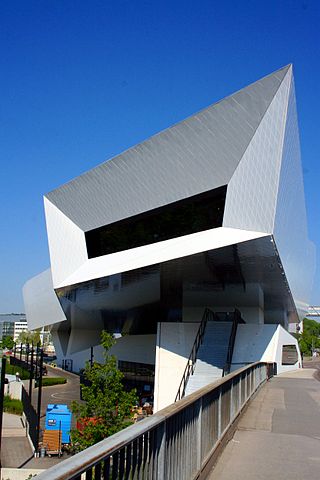
Vorarlberg is the westernmost state of Austria. It has the second-smallest geographical area after Vienna and, although it also has the second-smallest population, it is the state with the second-highest population density. It borders three countries: Germany, Switzerland, and Liechtenstein. The only Austrian state that shares a border with Vorarlberg is Tyrol, to the east.

The Bregenz Forest is one of the main regions in the state of Vorarlberg (Austria). It overlaps, but is not coterminous with, the Bregenz Forest Mountains, which belong to a range of the Northern Limestone Alps, specifically the northern flysch zone. It is the drainage basin of the Bregenzer Ach river.

Karl Heinz is an Austrian architect. With two colleagues, as the firm Heinz & Mathoi & Streli, he built private homes in the alpine landscape of Tyrol, schools, offices and public buildings, among others.

Baumschlager-Eberle is a partnership of architects in Austria.
Franz Reznicek was an Austrian architect. After moving to Bludenz, Vorarlberg, where he initially headed an architectural firm with Alois Dönz, he was responsible for the design of numerous modernist buildings in the area during the 1930s.
Szyszkowitz + Kowalski is an Austrian-German architectural design team made up of Karla Kowalski and Michael Szyszkowitz. Their studio in Graz was established in 1978. Szyszkowitz + Kowalski are regarded to be major co-founders of the internationally renowned Grazer Schule. Originating in Graz in the 1970s, this name stands for architectural individualism of an especially creative type. Szyszkowitz + Kowalski put great emphasis on three-dimensional and expressive architectural language with a distinctive reference to landscape and context.

Vittorio Magnago Lampugnani is an architect, architectural theorist and architectural historian as well as a professor emeritus for the History of Urban Design at the Swiss Federal Institute of Technology Zurich. He practices and promotes a formally disciplined, timelessly classic, and aesthetically sustainable form of architecture, one without modernist or postmodernist extravagances. As an author and editor of several acclaimed works of architectural history and theory, his ideas are widely cited.

Michael Trieb was a German architect, urban planner (SRL) and university professor. He was head of the Department of Urban Design at the Urban Planning Institute at the University of Stuttgart and is now Managing Director of the ISA Group - ISA Internationales Stadtbauatelier.
E2A Architects is an Architecture firm based in Zürich, Switzerland. The office is led by Piet Eckert and Wim Eckert who founded E2A Architects in 2001.
Ella Briggs was an Austrian architect.

José Ignacio Martínez is a photographer from Navia, Asturias, Spain who is specialized in architecture photography. Since he was a child Martínez was connected to photography through his contact with amateur and professional photographers, including his father, Jesús Martínez, a doctor, historian and photographer. (Gea, J.C., Donde habita la belleza, La Nueva España, 12 de julio de 2009, retrieved 19 December 2016). These experiences allowed him to learn how to handle various manual cameras, like the mythical Nikon F, and learned the use and tricks of the dark room, the enlarger, the chemical used in processing and other methods used on that time.

The Institute for the History and Theory of Architecture is a teaching and research institute at the Department of Architecture of ETH Zurich, situated on the ETH Zurich’s Hönggerberg Campus site.
Ákos Moravánszky, is a Swiss-Hungarian architect, theorist, historian and Adjunct Professor Emeritus of Architectural Theory at the Institute for the History and Theory of Architecture at the Swiss Federal Institute of Technology in Zurich. Moravánszky is regarded as one of the world's leading architecture historians of Central European architecture.
Jörg Streli was an Austrian architect and academic teacher at the Innsbruck University. With two colleagues, as the firm Heinz & Mathoi & Streli, he built private homes in the alpine landscape of Tyrol, schools, offices and public buildings, among others. He was also president of the architecture section of the Ingenieur- und Architektenkammer für Tirol und Vorarlberg.
Dieter Mathoi was an Austrian architect. With two colleagues, as the firm Heinz & Mathoi & Streli in Innsbruck, he worked for 35 years, building private homes in the alpine landscape of Tyrol, schools, offices and public buildings, among others. He opened his own office in 2008 and was known for prison buildings and for designing the controversial Kaufhaus Tyrol in Innsbruck with David Chipperfield.

Ernst Hiesmayr was an Austrian architect, artist and former rector of the Technical University Vienna.

Delugan Meissl Associated Architects (DMAA) is an Austrian architecture firm based in Vienna, Austria. DMAA has designed notable buildings including the Porsche Museum, Stuttgart and the EYE Film Institute Netherlands.

Marc Kocher is a Swiss architect, known for his residential building designs.
Felix Gottfried Wehling was a German architect.

The Montforthaus Feldkirch is a multi-purpose cultural centre in Feldkirch, Vorarlberg (Austria). It is used for conventions, balls, trade fairs, concerts and theatre performances.











